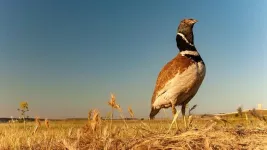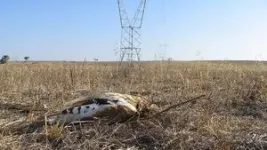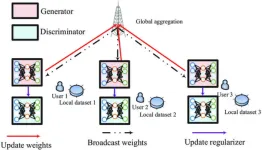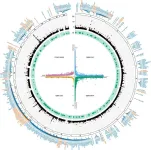(Press-News.org) The collaboration between scientists, farmers and managers is crucial to improve the protection of the little bustard, an endangered steppe-land bird in Spain due to human activity. The reduction of natural habitats, the increase in irrigation and the urbanization of the land have led to having less surface areas that guarantee the survival of this vulnerable species. An article published in the journal Biological Conservation reveals how cooperation between different actors is key to finding answers and avoiding the decline of the most threatened populations of the little bustard.
The study, a pioneer example of adaptative conservation, is signed by the experts Santi Mañosa, from the Faculty of Biology and the Biodiversity Research Institute (IRBio) of the University of Barcelona, and Gerard Bota, from the Conservation Biology Group of the Forest Science and Technology Center of Catalonia (CTFC).
An endangered steppe-land bird
For birds such as the little bustard (Tetrax tetrax), it is becoming increasingly hard to find suitable habitats due to the reduction of steppe-land and the disappearance of traditional agriculture and livestock farming. The study states that growing the area of fallow lands — the unsown farmland — helps to stabilize the population of the little bustard in Catalonia.
“This strategy has a positive impact on the little bustard, mainly because it increases the reproductive success, for it provides the species with everything that has disappeared in the rain-fed agricultural environments as a result of the intensification of agricultural practises”, notes Professor Santi Mañosa, from the UB’s Department of Evolutionary Biology, Ecology and Environmental Sciences.
“In spring, — he continues — they find food, places for the males to stop and attract females, mate, nest and feed the baby birds. In summer and autumn, and a great part of the winter, when crops are reaped and cultivated, fallow lands are the only places with enough plants to provide the little bustard flocks shelter and food”.
However, fallow lands have lost interest from a productive and agricultural perspective, and they are in regression in Spain. “Between 2009 and 2018, 21% of the fallow land surface has been lost in Catalonia, according to the latest State of Nature in Catalonia report, published in 2020, and steppe-land bird populations have reduced by 27% between 2002 and 2019, mainly due the loss of fallow lands (as one of the main causes)”, notes expert Gerard Bota. “The little bustard is one of the most affected birds and one of the few species to have suffered a major decline in Catalonia and other areas of Spain in a short period of time. As a result of this situation, it is currently catalogued as an endangered species in Spain, the same level of threat of other emblematic species such as the bearded vulture, the brown bear or the Iberian lynx”.
What to do besides promoting fallow lands
The population models generated in this study show that increasing the surface area of fallow lands could certainly halt the decline of the species towards its disappearance, “but this measure, albeit essential, is not enough to recover the population numbers, since adult mortality — particularly in females — is still excessive”, warns Santi Mañosa.
.
“It will be essential to implement other conservation measures that have not been worked on much to date”, notes Gerard Bota. “For instance, reducing the mortality of adult females, mainly anthropogenic, which is the one we can manage. We know the little bustard is sensitive to death by collision with power lines because of its relatively reduced frontal vision when flying. It would be necessary to identify the main areas of post-breeding and winter aggregation and to act on the power lines installed to reduce the probability of death of the specimens. In the most important breeding and hibernation areas, some lines should be buried or eliminated, and in the rest of the areas, the lines should be properly marked with anti-collision elements”.
Generating trust and cooperation among different sectors
In 2009, a total of eight Special Protection Areas for Birds (SPAs) were declared in the steppe sectors of the Lleida Plain, aiming to protect the most important population of little bustard. Over an area of 47,360 hectares, the land use is regulated so that, in theory, the populations of steppe birds can be maintained. "In these areas, the most important measure that has been carried out so far to favour the populations of little bustards has been to lease and manage up to 3,400 hectares of fallow land, where the little bustards can find refuge and food to breed and spend the winter", says Mañosa.
Building trust and cooperation between different sectors related to land and biodiversity conservation is the cornerstone for finding solutions to ecological challenges in increasingly complex systems.
"Adaptive management is an effective process that managers can use to incorporate uncertainty of outcomes into the management model, learn from their actions and achieve the desired results. A key step in this process is the rigorous monitoring and evaluation of management interventions. For this, the work in the same direction of different actors involved in the implementation — Department of Climate Action and Rural Agenda, public companies, managers and scientists — has been key to the success of the measure", says Bota.
This model of adaptive conservation, "which involves the management of complex socio-ecological systems with the interests of very different groups, is exportable to other scenarios that require the application of actions — with an unknown or uncertain outcome — with the participation of very diverse actors", concludes Mañosa.
END
Scientists, farmers and managers work together to avoid the decline of the little bustard, an endangered steppe bird
Generating trust and cooperation among different sectors
2024-01-18
ELSE PRESS RELEASES FROM THIS DATE:
Better wireless communication made possible through machine learning
2024-01-18
In today's increasingly interconnected world, high-quality communication has become more vital than ever. Accurately estimating the dynamic status of communication channels is a key factor in achieving this. Recently, a joint research team designed a new algorithm that offers high-level estimation accuracy and privacy protection with low computational and communication costs. This research was published Jan. 5 in Intelligent Computing, a Science Partner Journal.
This new algorithm uses a specially designed deep learning model for precise estimation and a federated learning framework ...
Study with over 11,000 individuals of African descent finds genetic variants linked to glaucoma
2024-01-18
Glaucoma is the leading cause of irreversible blindness around the globe, affecting up to 44 million people. Although people of African ancestry are most frequently and severely affected by this hereditary disease, its genetic underpinnings in this population have rarely been studied. Now, a team of investigators has published findings revealing previously unknown inherited genetic variants that contribute to primary open-angle glaucoma (POAG), the most common form of the disease. The study was based on the analysis of 11,275 individuals of African descent and is being published January 18, 2024, in Cell.
“Individuals with African ancestry are five times more likely to be affected ...
Economics: Sea level rises could cost EU and UK economies up to 872 billion Euros by 2100
2024-01-18
Damage caused by sea level rises could cost the EU and UK economies up to 872 billion Euros in total by the end of the century, according to a modelling study published in Scientific Reports.
Ignasi Cortés Arbués, Theodoros Chatzivasileiadis, Tatiana Filatova and colleagues modelled the potential economic impacts of sea level rises for 271 European regions by 2100 under a high emissions scenario (SSP5-RCP8.5) with no new coastal protection measures implemented after 2015. They combined ...
Genetics: Chewing over poor Mesolithic oral health
2024-01-18
Members of a hunter-gatherer group that lived in south-western Scandinavia during the Mesolithic era — approximately 10,000 years ago — may have been affected by tooth decay and gum disease, according to a study published in Scientific Reports.
Emrah Kırdök, Anders Götherström and colleagues sequenced the DNA found on three pieces of birch tar — a substance made from heated birch bark — that were excavated in the 1990s from Huseby Klev, Sweden and have been dated to between 9,890 ...
Mega-analysis identifies gene variants associated with glaucoma in people of African ancestry
2024-01-18
PHILADELPHIA— A new analysis focusing specifically on people of African ancestry identified three gene variants that may be contributing to this population’s susceptibility to developing and being blinded by glaucoma. People of African ancestry are five times as likely as others to develop glaucoma and up to 15 times as likely to be blinded by the condition, but the vast majority of research has used data from people of European ancestry. Led by researchers at the Perelman School of Medicine at the University ...
Third major study finds evidence that daily multivitamin supplements improve memory and slow cognitive aging in older adults
2024-01-18
By 2060, according to the Alzheimer’s Association, nearly one in four Americans will be in an age bracket at elevated risk of cognitive decline and Alzheimer’s disease unless interventions can help preserve cognitive function before deficits begin. The COcoa Supplement and Multivitamin Outcomes Study (COSMOS) is a large-scale, nationwide, randomized trial rigorously testing cocoa extract and multivitamin supplements directed by researchers at Mass General Brigham. Two previously published studies of cognition in COSMOS suggested a positive effect for a daily multivitamin. ...
Nurse home visits have a lasting impact for disadvantaged mothers and daughters
2024-01-18
Nurse home visits to disadvantaged mothers can significantly reduce their rates of hypertension and their daughters’ likelihood of obesity, finds a new reanalysis of health data by a team led by a UCL researcher.
The study, published in the journal JAMA Network Open, reanalysed data taken as part of a Nurse-Family Partnership trial started more than 30 years ago – The Memphis New Mothers Study (1990-1994). The researchers found that prenatal and infancy nurse home visits decreased the likelihood of daughters being obese by 55% and being severely obese by 81% in adolescence. Similarly, mothers of girls showed a decrease ...
Cannabis and driving in older adults
2024-01-18
About The Study: The findings of this study that included 31 participants ages 65 to 79 suggest that older drivers, even if they regularly use cannabis, show evidence of impaired driving performance after smoking cannabis. Weaving was increased and speed was decreased at 30 minutes after smoking, which was not correlated with blood tetrahydrocannabinol (THC) concentrations; subjective experience and self-reports of impaired driving persisted for three hours.
Authors: Patricia Di Ciano, Ph.D., of the Centre for Addiction ...
Neurostimulation for advanced Parkinson disease and quality of life at 5 years
2024-01-18
About The Study: This nonrandomized controlled trial of 108 patients with advanced Parkinson disease found that at 5-year follow-up quality of life remained stable in the deep brain stimulation of the subthalamic nucleus (STN-DBS) group and worsened in the standard-of-care medication group, mainly driven by the favorable effect of STN-DBS on mobility. These findings may provide helpful information when counseling patients on the efficacy of STN-DBS for Parkinson disease and monitoring patients postoperatively in long-term follow-up.
Authors: Stefanie T. Jost, Ph.D., and Haidar S. Dafsari, M.D., of the University of Cologne, Germany, are the corresponding ...
Monell Center study: New gut-brain circuits found for sugar and fat cravings
2024-01-18
Philadelphia, PA (January 18, 2024) – Understanding why we overeat unhealthy foods has been a long-standing mystery. While we know food's strong power influences our choices, the precise circuitry in our brains behind this is unclear. The vagus nerve sends internal sensory information from the gut to the brain about the nutritional value of food. But, the molecular basis of the reward in the brain associated with what we eat has been incompletely understood.
Now, a new study published in Cell Metabolism by a team from the ...
LAST 30 PRESS RELEASES:
Tracing the quick synthesis of an industrially important catalyst
New software sheds light on cancer’s hidden genetic networks
UT Health San Antonio awarded $3 million in CPRIT grants to bolster cancer research and prevention efforts in South Texas
Third symposium spotlights global challenge of new contaminants in China’s fight against pollution
From straw to soil harmony: International team reveals how biochar supercharges carbon-smart farming
Myeloma: How AI is redrawing the map of cancer care
Manhattan E. Charurat, Ph.D., MHS invested as the Homer and Martha Gudelsky Distinguished Professor in Medicine at the University of Maryland School of Medicine
Insilico Medicine’s Pharma.AI Q4 Winter Launch Recap: Revolutionizing drug discovery with cutting-edge AI innovations, accelerating the path to pharmaceutical superintelligence
Nanoplastics have diet-dependent impacts on digestive system health
Brain neuron death occurs throughout life and increases with age, a natural human protein drug may halt neuron death in Alzheimer’s disease
SPIE and CLP announce the recipients of the 2025 Advanced Photonics Young Innovator Award
Lessons from the Caldor Fire’s Christmas Valley ‘Miracle’
Ant societies rose by trading individual protection for collective power
Research reveals how ancient viral DNA shapes early embryonic development
A molecular gatekeeper that controls protein synthesis
New ‘cloaking device’ concept to shield sensitive tech from magnetic fields
Researchers show impact of mountain building and climate change on alpine biodiversity
Study models the transition from Neanderthals to modern humans in Europe
University of Phoenix College of Doctoral Studies releases white paper on AI-driven skilling to reduce burnout and restore worker autonomy
AIs fail at the game of visual “telephone”
The levers for a sustainable food system
Potential changes in US homelessness by ending federal support for housing first programs
Vulnerability of large language models to prompt injection when providing medical advice
Researchers develop new system for high-energy-density, long-life, multi-electron transfer bromine-based flow batteries
Ending federal support for housing first programs could increase U.S. homelessness by 5% in one year, new JAMA study finds
New research uncovers molecular ‘safety switch’ shielding cancers from immune attack
Bacteria resisting viral infection can still sink carbon to ocean floor
Younger biological age may increase depression risk in older women during COVID-19
Bharat Innovates 2026 National Basecamp Showcases India’s Most Promising Deep-Tech Ventures
Here’s what determines whether your income level rises or falls
[Press-News.org] Scientists, farmers and managers work together to avoid the decline of the little bustard, an endangered steppe birdGenerating trust and cooperation among different sectors




